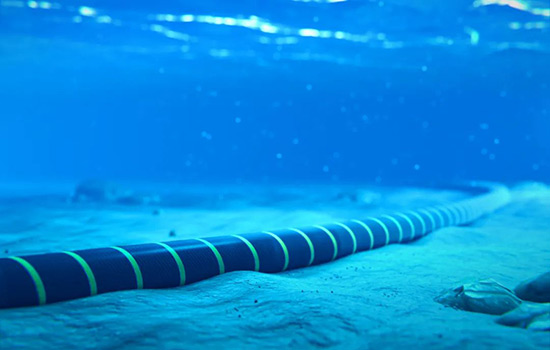

Il-kejbil sottomarini fl-istampa għandu ġakketta tal-kejbil oħxon.
Inġinerija tal-kejbils sottomarini hija rikonoxxuta mad-dinja kollha bħala proġett tekniku fuq skala kbira diffiċli u kumplessa.
Kemm id-disinn tal-kejbil, Manifattura, u t-tqegħid ta 'kostruzzjoni huma ħafna ogħla minn prodotti oħra tal-kejbil ġenerali.
Fosthom, huma l-ġonot intermedji tal-kejbil sottomarini, il-produzzjoni tat-terminali, installazzjoni, u wajers. U l-ikkummissjonar tat-test huwa wkoll parti importanti ħafna minn din l-inġinerija teknika kumplessa.
Il-produzzjoni tagħha, u l-kwalità tal-installazzjoni huma tajbin jew ħżiena, u s-sigurtà u l-affidabbiltà tat-trasmissjoni u s-substazzjoni kollha għandhom rwol importanti ħafna.
Kejbil sottomarini huwa mqiegħed fix-xmajjar, lagi, u kejbil tal-enerġija taħt l-ilma, Magħruf ukoll bħala kejbil taħt l-ilma.
Huwa mqabbel ma 'kejbils ibbażati fuq l-art, Hemm ftit differenza fl-insulazzjoni ewlenija.
Minħabba l-metodi speċjali ta 'kostruzzjoni u l-kundizzjonijiet operattivi tal-kejbils sottomarini, fl-armatura, Ġakketta tal-metall, Tul tal-manifattura. U aspetti strutturali oħra tad-differenzi akbar.
Kejbils sottomarini huma spiss manifatturati f'tulijiet kbar ta 'kejbils sħaħ, li għandhom jiġu mkebbsa f'ċirku għat-trasport.


Għalkemm l-armatura bi żift qasir tista 'tnaqqas id-dijametru tal-coiling. Il-kejbil ta 'sottomarini b'armatura ta' żift qasir huwa faċli li tkun għoqda taħt l-ilma meta tkun taħt tensjoni kbira fil-proċess tat-tqegħid.
Għalhekk, Il-pitch tal-armatura ġenerali jeħtieġ 12-14-il darba d-dijametru medju tal-armatura.
Biex tnaqqas id-dijametru tal-coiling, Xi wħud jużaw wajer tal-azzar stressat minn qabel jew doppju ta 'żift qasir Armatura tal-wajer tal-azzar, u xi wħud jużaw armatura bid-direzzjoni opposta tat-twist ta 'ġewwa u ta' barra.
Prinċipalment maqsum f'kejbil sottomarini bi tliet qalba u kejbil ta 'taħt il-qalba waħda, baxx- u linji ta 'vultaġġ medju bl-użu ta' kejbil sottomarini bi tliet qalba. U Linji ta 'vultaġġ għoli Bl-użu ta 'kejbil ta' sottomarini b'qalba waħda.
Nofs seklu ilu, Il-kejbil sottomarini huwa biss funzjoni ta 'trasmissjoni ta' enerġija elettrika sempliċi.
Issa l-kejbil sottomarini jintegra żewġ funzjonijiet, tirrealizza b'mod effettiv it-trasmissjoni ta 'enerġija elettrika u sinjali fuq l-istess kejbil.
Hemm kejbils sottomarini iżolati miżjuda biż-żejt u kejbils ta 'sottomarini iżolati tal-plastik.
Hemm kejbils DC u AC.
Kejbil sottomarini DC huwa kkaratterizzat minn telf baxx, Trasmissjoni ta 'enerġija fuq distanza twila faċli biex takka.
Madankollu, L-esperjenza tal-applikazzjoni tal-kejbil sottomarini DC mhix rikka. U l-ispejjeż tal-kostruzzjoni ta 'sostenn ta' stazzjonijiet ta 'konvertituri u oħrajn huma għoljin.
It-telf tal-kejbil tas-sottomarini AC huwa kbir, Iżda t-teknoloġija tal-operazzjoni u l-manutenzjoni hija matura, Appoġġ għall-ispejjeż żgħar tal-kostruzzjoni.
Għalhekk, Id-disinjaturi tal-linja tal-kejbil sottomarini ġeneralment ikollhom jagħmlu kompromessi tekniċi u ekonomiċi biex jimmassimizzaw il-benefiċċji.
L-istħarriġ tar-rotta tal-kejbil qabel it-tqegħid ta 'kejbils sottomarini jinkludi:
① Naddaf il-fond tal-ilma, Topografija, u kejl tal-profil stratigrafiku baxx taż-żona tar-rotta barra mill-kosta.
② Kampjunar tal-wiċċ tas-sediment, Kampjunar tal-kolonna, u stħarriġ statiku tal-mess.
③ Jinkludi wkoll stħarriġ dwar il-kundizzjonijiet tat-traffiku u tal-kostruzzjoni u ostakli li jirriflettu l-istatus tal-attivitajiet tal-iżvilupp tal-baħar.
Riċentement, l - użu ta 'pożizzjonament avvanzat ta' GPS wara l-proċessar u (Cpt) Teknoloġija statika tal-mess wassal għal żieda sinifikanti fil-veloċità tal-istħarriġ u l-effettività.
Il-proġett ta 'tqegħid tal-kejbil sottomarini huwa rikonoxxut bħala proġett kumpless u diffiċli fuq skala kbira minn pajjiżi madwar id-dinja.
It-tqegħid tal-kejbil għandu jikkontrolla l-angolu tal-kejbil fl-ilma u t-tensjoni tat-tqegħid billi jikkontrolla l-veloċità tal-qlugħ tal-bastiment li jpoġġi u l-veloċità tar-rilaxx tal-kejbil biex tevita li tagħmel ħsara lill-kejbil minħabba raġġ żgħir wisq tal-liwi jew wisq tensjoni.
Fl-ibħra baxxi, bħal fond tal-ilma ta 'inqas minn 200 Meters fil-baħar, Il-kejbil huwa midfun.
Fil-baħar fond, Il-kejbil huwa mqiegħed, u l-kejbil jiġi rilaxxat mill-bastiment li jħabbat il-kejbil. U l-kejbil huwa kontinwament immonitorjat u aġġustat bl-użu ta 'monitors taħt l-ilma u vetturi ta' kontroll mill-bogħod taħt l-ilma.
Ukoll, Ikkontrolla l-veloċità u d-direzzjoni 'l quddiem tal-vapur li jpoġġi u l-veloċità li tpoġġi l-kejbil biex tevita li tagħmel ħsara lill-kejbil billi taqbeż postijiet u blat irregolari.
Fl-aħħar stadju tal-kostruzzjoni, L-iskop ewlieni huwa li tipproteġi l-kejbil sottomarini bid-dfin fil-fond biex tnaqqas l-impatt tal-ambjent tal-baħar kumpless fuq il-kejbil sottomarini u tiżgura s-sigurtà operazzjonali.
Fiż-żona ramlija u silta, Trench madwar 2 Meters fil-fond huwa ġġenerat minn ilma li jlaħlaħ bi pressjoni għolja biex jidfen il-kejbil fih, U l-ħamrija ramlija ħdejnha tkopriha.
Għal sikka tal-qroll u żoni tat-tafal, Aqta 'trinka 0.6 – 1.2 metri fond bi cutter, Bury il-kejbil fit-trinka u mili mill-ġdid b'mod naturali biex tifforma protezzjoni.
Fiż-żoni tal-blat iebes, the cable needs to be covered with a cement cover and other hard objects to implement protection.
It is a wire wrapped with insulating material to isolate water from the cable, thus providing a waterproof function.
The cable is made in such a way that the cable is first embedded in a jelly-like compound that protects the cable from damage even in the event of contact with seawater.
Il- kejbil tal-fibra ottika is then packed into a steel tube to prevent the pressure of water from damaging it.
Li jmiss, it is wrapped in an overall very strong steel wire and snapped into a copper tube, u fl-aħħar, a protective layer of polyethylene material is applied.
Near the coast of the continental shelf, Kejbils sottomarini huma ġeneralment imqiegħda b'kejbils eħfef b'wajers tal-azzar aktar b'saħħithom u mgħottija b'kisja ta 'l-asfalt biex tevita l-korrużjoni mill-ilma baħar.
Kejbils tal-fibra ottika sottomarini huma suxxettibbli ħafna għall-korrużjoni tal-ilma baħar minħabba li huma mgħaddsa f'ilma tal-baħar ikkonċentrat ħafna għal perjodi twal.
Barra minn hekk, Il-molekuli tal-idroġenu jistgħu jinxterdu fil-materjal tal-ħġieġ tal-fibra, tagħmel it-telf tal-fibra akbar.
Għalhekk, Kejbils tal-fibra ottika sottomarini għandhom bżonn jipprevjenu kemm il-ġenerazzjoni interna ta 'idroġenu kif ukoll l-infiltrazzjoni ta' l-idroġenu fil-kejbil tal-fibra ottika minn barra.
Bħalissa, Kejbils tal-fibra ottika sottomarini huma mibnija billi tgeżwir spirali tal-fibra ottika darba jew darbtejn miksija madwar iċ-ċentru u li jsaħħu l-membri madwaru.
Hawn fuq hija introduzzjoni għal kejbils sottomarini. Jekk għandek xi mistoqsijiet dwar ix-xiri tal-kejbil, Merħba għall-kejbil ZMS Like.
When people hear the term mineral insulated cable, many immediately think of harsh environments like…
As telecommunication networks and power transmission systems grow rapidly, the demand for reliable and cost-effective…
In large-scale oil and gas projects, industrial cables are not just accessories—they are the "nervous…
In the world of electrical connections, cable lugs—also known as cable ears or cable terminals—huma…
When choosing the right rubber cable for an electrical engineering project, it is critical to…
Għeżież Imsieħba u Klijenti: 29 ta 'Jannar, 2025 Is-Sena l-Ġdida Lunar Ċiniża hija – Spring…